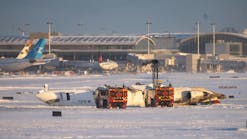Investigators in Toronto Looking at Weather, Runway Conditions, Pilots in Crash of Delta Jet
As investigators piece together how Delta Air Lines Connection Flight 4819 crash-landed at Toronto Pearson International Airport, experts are pointing to weather, runway conditions and piloting as potential factors.
The flight, which left Minneapolis-St. Paul International Airport around 11:34 a.m. and was operated by Endeavor Air, carried 76 passengers and four crew members. No fatalities were reported in the fiery crash, but 21 people were transported to area hospitals for medical treatment.
Delta said in a statement that 19 of them had been released from the hospital as of Tuesday morning.
“Our most pressing priority remains taking care of all customers and Endeavor crew members who were involved,” Delta CEO Ed Bastian said in a statement.
Weather conditions will be under close scrutiny in the crash investigation. At Toronto Pearson on Monday there were wind gusts up to 40 mph with chances of snowfall, according to AccuWeather.
The plane that crashed is a CRJ-900, according to the Federal Aviation Administration. The Transportation Safety Board of Canada is leading the crash investigation.
The federal National Transportation Safety Board, which handles U.S. transportation disasters, has sent a team to assist. Typically the agency tries to complete an investigation within two years. The NTSB has said all information about the crash investigation will come from Canadian authorities.
Les Abend, a retired American Airlines pilot, told the Minnesota Star Tribune on Tuesday the experience of the crew will be a consideration.
Abend, who cautioned his analysis was speculative and based on early information, said the signs of the crash point to what pilots call landing “in a crab,” a reference to the position of the aircraft at the time the wheels touch the ground. The plane appeared to hit the ground hard, he said, which in the wrong position can cause parts of the landing gear to shear off.
“It takes some real pilot stuff to get this airplane down in a crosswind,” Abend said.
Abend added the plane may have landed in slippery conditions that changed quickly, though modern airplanes are equipped with anti-skid technology to prevent crashes in those situations.
Investigators looking at the crash will consider myriad factors, Abend added, from the interviews with passengers and flight attendants down to how much sleep crew members got the night before. Other conditions that will be considered, he said, include directions from air traffic control, digital flight data, voice recordings from the cockpit and how much general experience crew members have.
“I guarantee you, there won’t be one probable cause factor, there’ll be numerous factors involved,” Abend said.
J.F. Joseph, who runs Joseph Aviation Consulting, agreed that it’s too early to speculate on exactly what caused the crash, but the weather will be investigated as an important factor.
“Maneuvering crosswinds can be challenging,” Joseph told the Minnesota Star Tribune, noting conditions 500 feet above the runway can be dramatically different than those on the ground. “No two crosswinds are alike; they are dynamic. That presents additional challenges to the pilot.”
Videos of the crash shared on social media showed terrified passengers suspended in their seats, on the ceiling, and then being ushered out the airplane door by crew members.
In another, which captures the full landing, the right wing of the plane appears to touch the ground, shear off, as the fuselage rotates 180 degrees. As it turns over, the airplane’s other wing and tail are torn off and flames roll out.
During a Tuesday press conference, airport public safety officials offered no clear cause of the crash, pointing to the ongoing investigation by Canada’s TSB.
First responders said the majority of passengers suffered back sprains, head injuries, headaches, anxiety and nausea due to jet fuel exposure. Details on the two passengers who remained in the hospital on Tuesday remained sparse, though officials said no one had a life-threatening injury.
Deborah Flint, the Greater Toronto Airports Authority’s president and CEO, said the airport was coming off serious weather conditions last week that led to hundreds of flight cancellations as more snowfall accumulated in the span of a few days than in all of last winter.
But she said Monday’s clearer conditions had offered an opportunity for an operations makeup day ahead of the disaster with Delta flight 4819.
Flint declined to discuss weather conditions or other factors that may have played a role in the crash Tuesday, saying she looked forward to being able to share those at “the proper time.”
Toronto Pearson Fire Chief Todd Aitken had said Monday evening that the runway was dry and clear of crosswind conditions. But on Tuesday, the chief declined to answer questions about cause, directing those to the TSB.
Toronto officials further described the public safety response as “textbook,” while also applauding the airline workers who helped passengers escape the fiery wreck.
The crash on Monday came as the public is expressing unease with air travel in the wake of aviation disasters.
On Jan. 29, the U.S. saw the worst crash in recent memory when an American Airlines passenger plane collided midair with an Army helicopter, leaving 67 dead. Two days later, a medical transportation plane crashed in Philadelphia killing six people, and 10 people were killed in a crash in Alaska on Feb. 6.
Meantime, President Donald Trump’s administration is facing criticism for the firings of hundreds of FAA probationary employees as the agency has had a shortage of air traffic controllers. The employees received notifications of their terminations via email last week and were apparently decided without cause or evaluation of performance, according to the Professional Aviation Safety Specialists union.
Those terminations would not have factored into the crash on Monday, as Canada has its own air traffic controllers.
Flint said Mitsubishi representatives, alongside members of the U.S. Federal Aviation Administration, were among those on site to assist the 20 TSB investigators on site. The crashed plane was expected to remain on the site for at least 48 hours, Flint added, as inspections were underway.
Though the plane was manufactured by Bombardier, based in Montreal, Mitsubishi bought the jet program, the companies announced in 2019.
The flight was operated by Delta’s wholly owned subsidiary Endeavor Air, which handles regional connection flights. Endeavor is headquartered in Minneapolis.
Major commercial airlines, like Delta, contract many of their smaller routes to smaller regional carriers. Passengers may not realize they are flying on a regional airline as tickets, aircraft logos and cabin interiors all reflect the major carrier.
Bastian, Delta’s CEO, said the company will continue to support its customers and crew members.
“We’ll do everything we can to support them and their families in the days ahead, and I know the hearts, thoughts and prayers of the entire Delta community are with them,” Bastian said in a statement. “We are grateful for all the first responders and medical teams who have been caring for them.”
Delta was offering a travel waiver for customers scheduled to fly into Toronto through Thursday.
Delta sent its own incident response team Monday with employees specializing in customer care and support.
Delta resumed air travel to Toronto on Tuesday. The company was using bigger airplanes “to allow for greater arrival and departure capacity,” according to its statement.
_____
©2025 The Minnesota Star Tribune. Visit startribune.com. Distributed by Tribune Content Agency, LLC



